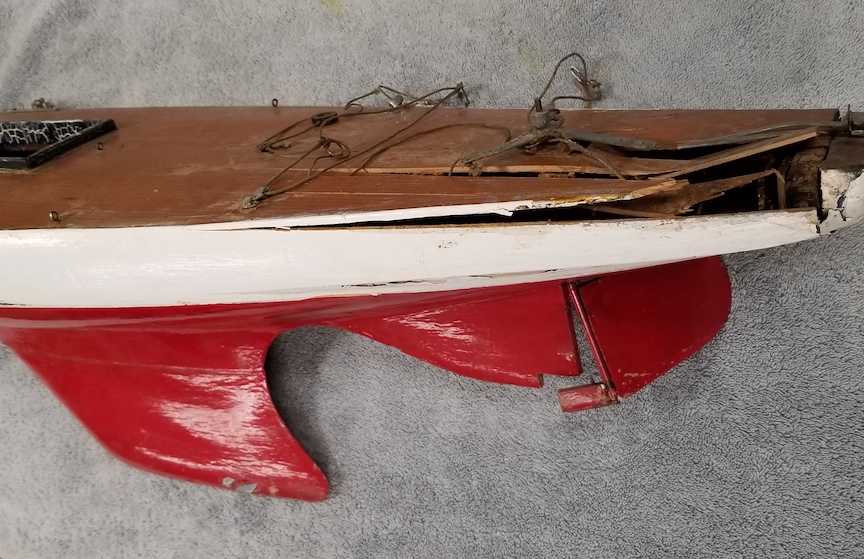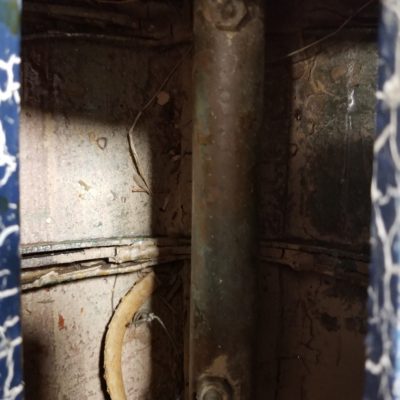Model Yacht Restoration Decision Making
by Rod Carr, Photos John Stoudt
Decisions about restoration and preservation of a vintage model yacht may be based on an identification of the importance of the actual model in the history of model yachting. It is suggested that as much information as possible be obtained about the model before attempting a restoration. This information should go into the project file as background for the Restoration Plan.
Category Designation (importance of the model)
There are three categories of importance.
Category I—Model yachts that are historically significant by virtue of taking part in a historic event such as Bill Bithell’s Ranger (International A boat won the 1948 Model Yachting Monthly Cup) and Ains Ballantyne’s DX Class champion. From a historical perspective, such yachts should be restored to represent the event for which they are most famous.
Category II—Model yachts that are historically significant due to technological features in hull design or rigging or for being prototypes for designs that became historically significant. Yachts in this category should be restored to highlight the features for which they are most noted, such as the M class “flipper” keel, etc.
Category III—Model yachts that are not significant in their own right but that represent a historically significant model class, type, or construction. The goals of the restoration should be based upon an identification of the model and its assignment to one of these three categories. This is the first part of the restoration plan, and unguided demolition can be avoided. Then a complete restoration plan can be developed to guide the effort.
Condition Assessment
The next step in any restoration project is to identify the existing condition of the original yacht. The condition descriptions on the following page are suggested:
Level 1 Condition—Yacht is in undeteriorated, pristine condition, and could be exhibited or sailed as is.
Level 2 Condition—Yacht is in “recent use, well cared for” condition. Suitable for exhibit as is or for sailing with attention to watertight integrity or rigging and sail condition. Wear should be the result of use, rather than neglect.
Level 3 Condition—Yacht is in deteriorated and/or unstable condition. It requires treatment, preservation and restoration.
Level 4 Condition—Yacht is derelict, destroyed or partially completed.
The Restoration Plan
A written Restoration Plan should be completed before any work commences on the yacht. The plan should contain photographs of the “as found” condition, notes on the integrity of the hull, lists of missing pieces, and any other historical background that can be gathered.
The Plan documents the basis of the decisions made to guide the restoration. It answers the question: What is the goal of the rehabilitation? It establishes the boundaries within which the restoration work will be carried out and provides the guidance for choices that must inevitably be made while the work is ongoing. Commercial restorations that the author carries out for clients, typically include a statement of the final configuration to be attained and a list of individual worktasks that will be completed to reach that end.
Two to three pages seems typical for all but the most comprehensive projects. Failure to take the time to do the research and develop the Restoration Plan will ultimately result in a hodgepodge approach to the project as it unfolds. Having first decided what the finished product is going to be (see below), individual details of the work can be carried out in a consistent manner.
Document the Boat
Documentation of the project from photographs of the “as received” condition to the completed project should be filed in a project notebook which remains with the yacht. A narrative report of the project would make a good submission to The Model Yacht. As in any historical undertaking, there is a continuous question of how far to go in totally reproducing an antique object. It is the author’s opinion that modern day adhesives and sail materials do not materially detract from the authenticity of the final product, nor does the application of modern radio control systems because they do not materially alter the external appearance of the model.
However, the author does balk at modifications to the original that are obvious attempts to gain advantage on the race course. It is my opinion that vintage yachts are to be sailed, seen, and enjoyed … the order of crossing the finish line in a demonstration race is little of the attraction.
Description of the Finished Project
The following descriptions are suggested to describe the finished product:
Original—Yacht is in original as-built condition, or if modified by the user it remains unaltered from the time it ended service.
Example: Bithell’s Ranger (A-class)
Restored Original—Yacht is composed of at least 50% original components (by surface area or volume) and the remainder returned to accurate early condition made with the same materials, components and accessories.
Reproduction—A reasonable facsimile in appearance and construction of a yacht
made with similar materials and essentially the same operating systems. In the case of a vane yacht having radio installed, might more properly be called “Reproduction for R/C”.
Example: Wooden hulled Cheerio II from John Black’s Plans.
Replica—A reproduction built from original plans, but using materials not found in the original.
Example: J.R. LeBlanc’s fiberglass- hulled Cheerio II
Example: Steadman’s M-Class Arrow (~1949)
Completed Project Description
Category I – First US DX Class Champion, first R/C national event – 1952.
Condition: Level 2 – Rig missing, deck in need of repair, some original R/C gear.
Restoration Plan – Restore yacht to R/C sailing condition; provide replacement rig and new R/C gear. Photos of original rig obtained from prior owner.
Finished Product – Restored Original – hull, deck, keel, skeg, rudder, deck fittings original. New Sitka spruce mast, booms from 1972 vintage M-class boat, Carr paneled 2-oz Dacron sails, modern Futaba R/C gear, Ozmun Swing-arm winch. Included working stand of 5⁄8-in plywood, and display stand of 1-in teak. Approximately 450 h of work were involved in the restoration.


